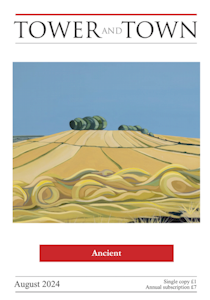

Tower and Town, August 2024 (view the full edition) (view the full edition)The Hancocks of Marlborough Cottage
In St Peter's church in May 1778, Betty Colman married Marlborough cabinet maker, James Hancock. They must have been dynamic, forward-thinking parents who encouraged curiosity and enterprise among their children. Not only did their daughter, Elizabeth, follow a cabinet-making apprenticeship but three of their sons Thomas, Walter and Charles made a name for themselves beyond the town. Moving to London, Thomas developed rubber manufacturing in Britain, Walter built steam powered road vehicles and Charles was both a renowned painter and patented gutta-percha coating of electrical cables used for telegraph cables across the Atlantic. The full story is to be found in 'The Hancocks of Marlborough' (2010, Oxford University Press), the definitive account of the Hancock brothers by John Loadman and Francis James (three times great nephew of Thomas). A busy and productive life in London did not mean that Thomas Hancock forgot his home town or his family. In his will of 1857 his address is given as Marlborough Cottage, Stoke Newington. The house was probably built in late 1836 which corresponds with Thomas (who never married) taking responsibility for the upbringing of his brother's children after John died in 1835. The census of 1851 shows that four nieces and two nephews, a general servant and gardener were living there. As you can see "Cottage" was a misnomer. Writing of his visits to the 'cottage' as a schoolboy in the late 19th century the great great nephew of Thomas, the Revd. J.L.B James, describes Thomas' laboratory: "To the left of the front door were the 'iron-door room' and the drawing room. The former gained its name from the corrugated metal door painted in oak graining. This room was of some interest, it was the laboratory of Thomas Hancock, the friend of Faraday and the partner of Charles Macintosh: it was in this room that he discovered the process of vulcanizing india-rubber. It remained exactly as it had been at the time of his death in 1865. From this room a private staircase ascended to his bedroom, and as the idea for the crucial experiment occurred to him whilst he was in bed, he came down at once, made the experiment and thus came about one of the great discoveries of the world". In May 1936 the Times celebrated the centenary of Walter Hancock's steam carriage service from Paddington to Bank. In a letter soon afterwards the Revd. James pointed out that this was inaccurate as the first one took place in April 1832. He also included a description of Walter's last machine. "In 1837 Hancock designed his last recorded road carriage, a steam phaeton for his own use. The normal speed of this vehicle was 12mph though it was capable of 20mph running smoothly and emitting neither noise, steam, fire nor smoke. Perhaps it may be of interest to add that I have often heard a description of a ride in it from my great aunt, the late Miss Harriet Hancock, the designer's niece who died at Marlborough Cottage...in 1909, a house still standing, occupied by the family for nearly 100 years, and in which...Thomas Hancock, made the memorable experiment by which he discovered the process of vulcanising india-rubber." After Thomas' death, three of his nieces remained in residence until their deaths: Frances in 1895, Maria in 1902 and Harriet in 1909. The house then remained empty until its demolition in 1945, after a V2 rocket had landed nearby, shaking the old building and taking one life. After its demolition a block of flats, Banstead Court, was built on the site. On October 8th 2003 the Plastics Historical Society placed a plaque there to celebrate the life and work of Thomas Hancock. It was unveiled by one of the four great great great nephews and nieces of Thomas who attended the ceremony. In turn, in around 2015, Banstead Court itself was demolished and replaced by an extensive block of flats - Willowbrook House. The plaque was removed during demolition, restored, and replaced above the entrance by the PHS in 2022. Acknowledgements Sarah Bumphrey |